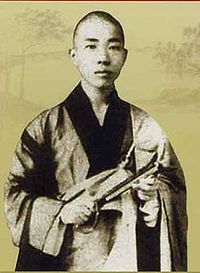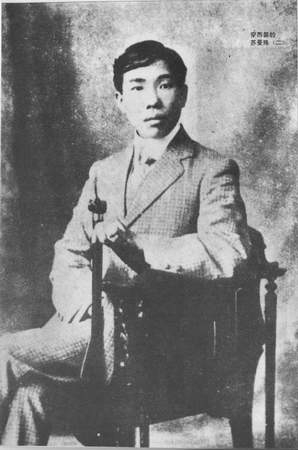Views
Sū Mànshū 蘇曼殊 (1884-1918)
Names 名: Jiǎn 戩, Yuányīng 元瑛, Xuányīng 玄瑛 |
| Notable Associates: |
| Erik Hammerstrom |
Sū Mànshū 蘇曼殊 (1884-1918)
Note: Not to be confused with Mànshūjiēdì 曼殊揭諦
An important artist and writer of the late Qing and early Republican periods. Mànshū was also a sometimes monk, and one of the first Chinese Sanskritists of the modern period.
Biography
Mànshū was the son of a Chinese businessman and a Japanese woman from Yokohama. With the outbreak of the First Sino-Japanese War in 1895, Mànshū returned with his father to his father's ancestral home in Guǎngdōng 廣東. Because he was the son of a foreigner, Mànshū was neglected by his family, so his father sent him to Hong Kong where he studied English under a Spanish pastor.
Four years later his father's family suffered financial setbacks, and Mànshū and his mother had to return to Yokohama. There he enrolled in school with the help of other Chinese kin, Mr. Lín 林, who supported him until 1902. Mànshū was able to continue his schooling after 1902 with the support of a charitable organization. While in school he joined various revolutionary youth groups, participating in an anti-Russian drill squad. During this time he became acquainted with Fèng Zìyóu 馮自由 who connected him with Chén Shǎobái 陳少白 in Hong Kong.
After arriving in Hong Kong, Mànshū was tonsured under Zànchū 贊初 at Huìlóng Temple 慧龍寺. Though he technically remained a monk all his life, it is well known that Mànshū ate meat, drank alcohol, and was otherwise not entirely diligent about keeping the precepts.
After ordination, Mànshū went to Shànghǎi 上海 for a period, during which time he wrote several essays for local newspapers. With the help of his former English teacher, Mànshū traveled to Bangkok, where he studied Sanskrit, then traveled to Sri Lanka to continue his studies before returning to Shànghǎi. From there, he traveled to Hángzhōu's 杭州 Língyǐn Temple 靈隱寺, where he began working on a Sanskrit dictionary. From 1905 to 1907 he taught at a number of different schools in Nánjīng 南京 and Chángshā 長沙. In 1907, he returned to Japan, where he lived with Zhāng Tàiyán 章太炎. During this period he completed a number of his major paintings.In 1908, Mànshū accepted the invitation of Yáng Wénhuì 楊文會 and taught English at the latter's newly-opened Jetavana Monastery 祇洹精舍 in Nánjīng, but because of illness Mànshū was forced to leave this position after only one term. After recovering, he served as a translator for Japan's Sanskrit Society 梵文會, traveling to Singapore and India.
After the founding of the Republic, Mànshū traveled around in Japan and China's Jiāngnán 江南 region. In Shànghǎi, he was a member of the Southern Society 南社, and became friends with Liǔ Yàzǐ 柳亞子 and Lǐ Shūtóng 李叔同 (who later became the famous Vinaya master Hóngyī 弘一).
Mànshū became very ill in Shànghǎi during the summer of 1917. He passed away the following spring.
Important Works
Notable Students
Notes
References:
- Liú Xīnhuáng 劉心皇. Sū Mànshū dàshī xīnzhuàn 蘇曼殊大師新傳 (A New Biography of Master Sū Mànshū). Taipei: Dongda tushu, 1992.
- Yú Língbō 于凌波, ed. Xiàndài Fójiào rénwù cídiǎn 現代佛教人物辭典 (A Dictionary of Modern Buddhist Persons), 2 vols. Taipei: Foguang, 2004. Pp. 1.929a-931c.

